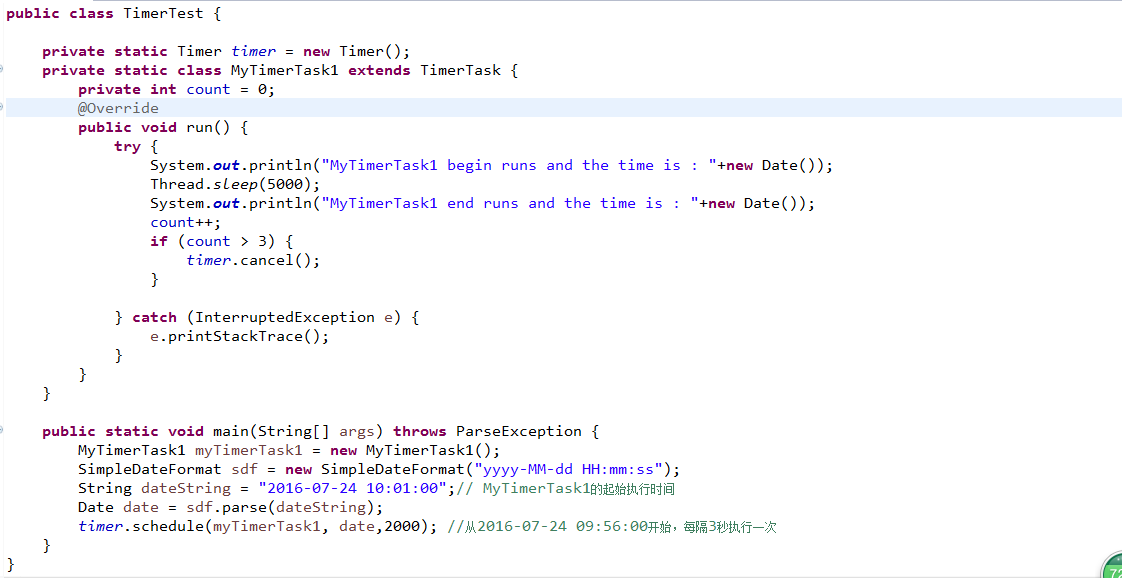在java中,定时计划任务功能主要使用的就是Timer对象,主要有如下技术点:
- 实现指定事件执行指定任务
- 实现按照指定周期执行任务
定时器Timer
schedule(TimerTask task,Date time)
该方法的作用是咋爱指定的日期执行一次某一任务。这里分两种情况
- 执行任务的任务晚于当前时间,在未来执行
- 执行的时间早于当前时间,提前运行
在未来执行
public class TimerTest {
private static class MyTimerTask extends TimerTask {
@Override
public void run() {
System.out.println("MyTimerTask runs and the time is : "+new Date());
}
}
public static void main(String[] args) throws ParseException {
MyTimerTask myTimerTask = new MyTimerTask();
SimpleDateFormat sdf = new SimpleDateFormat("yyyy-MM-dd HH:mm:ss");
// 这里设置的时间是在未来,此时时间到达该点的时候,会执行
String dateString = "2016-07-17 08:09:00";
Date date = sdf.parse(dateString);
Timer timer = new Timer();
timer.schedule(myTimerTask, date);
}
}多个TimerTask任务延时测试
由于TimerTask是以队列的方式一个一个被顺序执行的,所以执行时间可能和预期的时间不一致,如果前面的任务消耗时间较长,则后面的任务运行的时间也会被延迟。
public class TimerTest {
private static class MyTimerTask1 extends TimerTask {
@Override
public void run() {
try {
System.out.println("MyTimerTask1 begin runs and the time is : "+new Date());
Thread.sleep(30000);
System.out.println("MyTimerTask1 end runs and the time is : "+new Date());
} catch (InterruptedException e) {
e.printStackTrace();
}
}
}
private static class MyTimerTask2 extends TimerTask {
@Override
public void run() {
System.out.println("MyTimerTask2 runs and the time is : "+new Date());
}
}
public static void main(String[] args) throws ParseException {
MyTimerTask1 myTimerTask1 = new MyTimerTask1();
MyTimerTask2 myTimerTask2 = new MyTimerTask2();
SimpleDateFormat sdf = new SimpleDateFormat("yyyy-MM-dd HH:mm:ss");
String dateString1 = "2016-07-17 08:27:00";// MyTimerTask1的起始执行时间
String dateString2 = "2016-07-17 08:27:05";// MyTimerTask2的起始执行时间
Date date1 = sdf.parse(dateString1);
Date date2 = sdf.parse(dateString2);
Timer timer = new Timer();
timer.schedule(myTimerTask1, date1);
timer.schedule(myTimerTask2, date2);
}
}此时程序运行结果如下:
可以看到这里由于MyTimerTask1 执行需要花费30秒,那么将会影响task2的执行时间,task2以此时间为基准,向后延迟执行,因为task是被放入到队列中,一个一个顺序执行的。
schedule(TimerTask task,Date firstTime,long period)
该方法的作用是在指定的日期之后,按照指定的间隔周期性的无限循环执行某一任务。
MyTimerTask1 myTimerTask1 = new MyTimerTask1();
SimpleDateFormat sdf = new SimpleDateFormat("yyyy-MM-dd HH:mm:ss");
String dateString1 = "2016-07-17 08:51:00";// MyTimerTask1的起始执行时间
Date date1 = sdf.parse(dateString1);
Timer timer = new Timer();
timer.schedule(myTimerTask1, date1,2000);cancel()
- TimerTask类的cancel()方法:将自身从任务队列中清除
- Timer类的cancel()方法:全部人物都会被清除,并且进程被销毁
scheduleAtFixedRate(TimerTask task,Date firstTime,long period)
schedule和scheduleAtFixedRate主要的区别只在于不延时的情况:
- schedule方法:如果执行的任务时间没有被延时,那么下一次任务的执行时间参考的是上一次任务的开始时间来计算
- scheduleAtFixedRate方法:如果执行任务的时间没有被延时,那么下一次任务的执行时间参考的是上一次任务结束的事件来计算
chedule方法任务不延时
public class TimerTest {
private static Timer timer = new Timer();
private static class MyTimerTask1 extends TimerTask {
private int count = 0;
@Override
public void run() {
try {
System.out.println("MyTimerTask1 begin runs and the time is : "+new Date());
Thread.sleep(1000);
System.out.println("MyTimerTask1 end runs and the time is : "+new Date());
count++;
if (count > 3) {
timer.cancel();
}
} catch (InterruptedException e) {
e.printStackTrace();
}
}
}
public static void main(String[] args) throws ParseException {
MyTimerTask1 myTimerTask1 = new MyTimerTask1();
SimpleDateFormat sdf = new SimpleDateFormat("yyyy-MM-dd HH:mm:ss");
String dateString = "2016-07-24 09:56:00";// MyTimerTask1的起始执行时间
Date date = sdf.parse(dateString);
timer.schedule(myTimerTask1, date,3000); //从2016-07-24 09:56:00开始,每隔3秒执行一次
}
}这里,我们的时间间隔是大于task的执行时间的,也就是说,schedule方法任务不延时,此时,打印的结果如下:
schedule方法任务延时
这里,修改schedule方法任务延时,只需要,让运行时间隔的时间小于任务的执行时间即可,代码如下:

运行结果:
scheduleAtFixedRate方法任务延时
这里只需要修改上面的schedule方法为scheduleAtFixedRate即可,此时运行程序代码有如下输出:


























 499
499











 被折叠的 条评论
为什么被折叠?
被折叠的 条评论
为什么被折叠?








